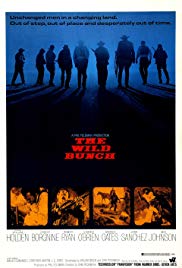Title: The Wild Bunch
Rating: 5 Stars
I recently watched this 1969 film. It’s number 79 on the 2008 AFI list. I don’t think that I’ve ever seen it before.
There’s a gang of aging outlaws. The year is 1913 and the Western era is coming to a close. While they ride around on horses, others are now driving cars. They attempt to rob a bank as their final score. However, the authorities are aware of their plan, and after the gang makes their bloody getaway, they discover that instead of gold coins that they just have bags of steel washers.
Now they need yet one more score to get away. They are still being chased down by a posse. They make contact with a Mexican general. They agree to rob a train of military weapons in exchange for gold. They manage to do so. The general pays them but realizes that one of the gang, a Mexican, has double crossed him. He lets the others go but then proceeds to brutally torture the captor. The gang decides to come back to try to rescue him, but in the resulting chaos (1969 spoiler alert!) a massive shootout takes place that essentially kills everyone.
I was pretty blown away by it, especially if you consider its historical context. It is a revisionist Western. Considering the fact that True Grit, the Western that finally won John Wayne his Oscar, also came out in 1969, this shows how revolutionary of a film it really was. According to legend, when Wayne saw The Wild Bunch he claimed that it ruined the Western genre forever.
A couple of things makes it different in comparison to previous Westerns. First of all, the protagonists are not particularly good guys. I’m not talking not a good guy like the irascible Rooster Cogburn of True Grit. I mean that they are legitimately bad guys. They are career criminals. In shootouts they cower behind innocent people that are shot dead. They have no problem shooting into crowds. When escaping, they abandon members of their gang to meet their inevitable deaths. They are always on the edge of dangerous anger. When not plotting their next move, they are drunk and consorting with prostitutes. They are dirty. Their teeth are rancid. In short, they are probably a bit more accurate representative of the typical Westerner of that time.
On the other side, the good guys aren’t that good either. In fact, the posse that’s hunting them down has been hired by the railroad. The railroad has no interest in justice. It just wants to see the men hunted down and killed. The leader of the posse has a personal stake in the hunt. He was a previous member of the gang who was summarily abandoned by them. The men that he is leading are themselves basically filthy, drunken criminals.
In short, there are no white hats here. These are men who just want to live another day so that they can drink, gamble, and carouse.
The other big difference here in comparison to previous Westerns is the extreme violence. I’m way too young to have seen it originally in the theater in 1969. Because it had such a huge affect on subsequent film, I’ve become somewhat inured to extreme violence. Therefore, I can’t imagine what the movie audience must have felt watching it. The film was barely able to be released in its current form. There are reports of people vomiting as they watched. Apparently close to 150 characters died in the film. There are two huge set pieces. One is the bank robbery gone awry when the bank robbers and their pursuers engage in a wild gun fight as a temperance parade marches through it. The second is at the end of the film where various members of the gang use a mounted machine gun to just mow down soldiers and bystanders alike. Nearly everyone dies in the carnage.
There are a couple of interesting things to note here regarding the violence. First of all, it’s not patient zero for this kind of action. Two years earlier, in 1967, Bonnie and Clyde was released. Much as The Wild Bunch would do for the Western genre, Bonnie and Clyde essentially reinvented the crime genre. It tried to take the romance out of it by showing the bank robbers as violent murderers. The final scene, where Bonnie and Clyde are shot down in their car in an ambush, is an orgy of violence. It’s pretty clear that Peckinpah was influenced by Bonnie and Clyde.
The other interesting thing of note here is the year, 1969. This was a tumultuous year in the US. This was the year after the riots at the 1968 Democratic convention. The revolutionary group The Weathermen conducted their Days of Rage in 1969. In 1968 over 16,000 American soldiers were killed in Vietnam and about 12,000 were killed in 1969. In total during the conflict, total deaths (all nations) were between 1.5 to 3.5 million.
One of the reasons that Peckinpah made the film so violent was to try to shock Americans into an awareness of all of this horror. In retrospect, instead of being shocked by it, he realized that Americans ultimately reveled in this violence. In later years, he regretted making the film.
Although he might have regretted making it, there is no denying its impact upon American cinema.
